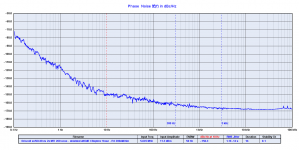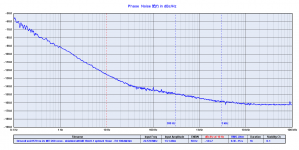I attach the phase noise plot of the new Driscoll oscillator that implements the Laptech 3rd overtone SC-Cut crystal at 22.5792 MHz at different drive levels.
The plot of the SC-Cut 11.2896 MHz crystal coming soon.
They look very good!
When can we expect the new driscoll pcb’s?
Regards,
I attach the phase noise plot of the new Driscoll oscillator that implements the Laptech 3rd overtone SC-Cut crystal at 22.5792 MHz at different drive levels.
The plot of the SC-Cut 11.2896 MHz crystal coming soon.
Very nice measure!
How did you measure, sine wave or the end of the squarer, HCMOS signal (this add more jitter)?
Hi Andrea,
Have you listen to the 5.xxx SC Cut and the new Discrol with your TDA1541A dac already ? Liked it ?🙂
Have you listen to the 5.xxx SC Cut and the new Discrol with your TDA1541A dac already ? Liked it ?🙂
We are still testing and tuning the new oscillators (Driscoll and differential), so expect at least a couple of months.
Very nice measure!
How did you measure, sine wave or the end of the squarer, HCMOS signal (this add more jitter)?
Sine wave, we are also working on a very low phase noise squarer circuit.
Hi Andrea,
Have you listen to the 5.xxx SC Cut and the new Discrol with your TDA1541A dac already ? Liked it ?🙂
Not yet, still testing and tuning the oscillators.
Hi all ...
Hmmm ... I would like to tread carefully here because this is not an area where I am that knowledgeable ... but comparing the phase noise of the SC-Cut at 22.58 MHz that was posted in #2017 with the phase noise of the AT cut at 11.29 MHz that Andrea posted in #5 - and considering that doubling an oscillator's frequency theoretically should give ~6 dB phase noise increase - then the SC-cut in #2017 is a couple dB worse at 1 Hz and 10 Hz and then the two oscillators are more or less equal when going up in frequency (the SC-cut could be a couple dB better at higher frequencies).
I do notice though that the RMS jitter value for the Driscoll cyan colored version (200uW drive level) is 8.9 fs whereas for the AT cut (Clapp) it is 0.4 ps - which is quite a difference.
Am I missing something - or do they measure more or less identical at lower frequencies (when considering the 6 dB phase noise increase per octave) ... ?
Cheers,
Jesper
Hmmm ... I would like to tread carefully here because this is not an area where I am that knowledgeable ... but comparing the phase noise of the SC-Cut at 22.58 MHz that was posted in #2017 with the phase noise of the AT cut at 11.29 MHz that Andrea posted in #5 - and considering that doubling an oscillator's frequency theoretically should give ~6 dB phase noise increase - then the SC-cut in #2017 is a couple dB worse at 1 Hz and 10 Hz and then the two oscillators are more or less equal when going up in frequency (the SC-cut could be a couple dB better at higher frequencies).
I do notice though that the RMS jitter value for the Driscoll cyan colored version (200uW drive level) is 8.9 fs whereas for the AT cut (Clapp) it is 0.4 ps - which is quite a difference.
Am I missing something - or do they measure more or less identical at lower frequencies (when considering the 6 dB phase noise increase per octave) ... ?
Cheers,
Jesper
Hi all ...
Hmmm ... I would like to tread carefully here because this is not an area where I am that knowledgeable ... but comparing the phase noise of the SC-Cut at 22.58 MHz that was posted in #2017 with the phase noise of the AT cut at 11.29 MHz that Andrea posted in #5 - and considering that doubling an oscillator's frequency theoretically should give ~6 dB phase noise increase - then the SC-cut in #2017 is a couple dB worse at 1 Hz and 10 Hz and then the two oscillators are more or less equal when going up in frequency (the SC-cut could be a couple dB better at higher frequencies).
I do notice though that the RMS jitter value for the Driscoll cyan colored version (200uW drive level) is 8.9 fs whereas for the AT cut (Clapp) it is 0.4 ps - which is quite a difference.
Am I missing something - or do they measure more or less identical at lower frequencies (when considering the 6 dB phase noise increase per octave) ... ?
Cheers,
Jesper
As I said the best phase noise performance is reached with SC-Cut overtone crystal around 5MHz (unloaded Q greater than 2M) and this has been demonstrated with the phase noise plots of both new oscillators using the 3rd overtone Laptech SC-Cut crystal at 5.6448MHz.
When the frequency of the crystal increases also the phase noise increases.
So I think the best solution is just to use an oscillator with a crystal at lower frequency (around 5MHz) followed by a frequency multiplier.
We are also working on a very low phase noise frequency multiplier.
Stay tuned!
and thank to the We as well as all the helpers of the thread 🙂 ... good to see open minds and shared knowledge working together...
@andrea_mori:
Sounds great, Andrea - looking forward to hearing more ...
🙄 ... somehow that is what this thread is about - isn't it
Cheers,
Jesper
We are also working on a very low phase noise frequency multiplier.
Sounds great, Andrea - looking forward to hearing more ...
Stay tuned!
🙄 ... somehow that is what this thread is about - isn't it

Cheers,
Jesper
Here you will find the original articles about the development of this low jitter oscillator:
Radio & Audio Artikelen
Bold articles are in English.
Radio & Audio Artikelen
Bold articles are in English.
Here you will find the original articles about the development of this low jitter oscillator:
Radio & Audio Artikelen
Bold articles are in English.
These articles are related to the first oscillator published in this thread, the Colpitts-Clapp using AT-Cut crystal.
The plots published in the last pages of the thread are related to a pair of totally different circuits using SC-Cut oscillators that have nothing to do with the Colpitts-Clapp: a differential circuit and a Driscoll type.
Wow, -150 dB at 10 Hz and -115 dB at 1 Hz.... nice. Andrea you may had hard times and tricky measurement environment to capture such low results in the low end...
Lookinf forward your listening feeling with the 5.6 SC-Cut.
Lookinf forward your listening feeling with the 5.6 SC-Cut.
Can you injection lock the 22MHz with the 5MHz? You may get a reduction in phase noise on the 22MHz. If you have both . . .
Can you injection lock the 22MHz with the 5MHz? You may get a reduction in phase noise on the 22MHz. If you have both . . .
It could be a nice solution but adds complexity and overall becomes a little expensive, so the first option to get better results at 22MHz will be starting from the 5MHz crystal followed by a couple of low noise frequency doubler.
great results. Congrats.
I see it is battery powered. Is an oven required to get this result?
I see it is battery powered. Is an oven required to get this result?
great results. Congrats.
I see it is battery powered. Is an oven required to get this result?
Until now the tests have been done without an oven, but we will test both oscillators with the oven to understand if there are difference.
- Status
- Not open for further replies.
- Home
- Source & Line
- Digital Line Level
- The Well Tempered Master Clock - Building a low phase noise/jitter crystal oscillator

